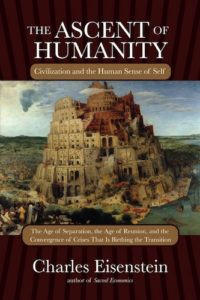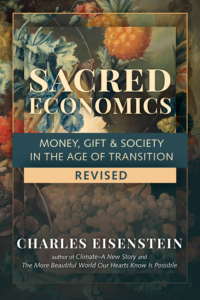Climate — A New Story
Chapters
Chapter 4: The Water Paradigm
Five Thousand Years of Climate Change
The Standard Narrative of climate change contends that climate was relatively stable until the twentieth century, when industrial emissions started to become significant. Whether or not this is the case in terms of temperature, in terms of water the last few thousand years have seen dramatic changes in climate. The earth has become significantly drier, and I am afraid that yes, much of the blame rests on the shoulders of human civilization.
According to some researchers, the buildup of CO2 and methane was well under way long before the Industrial Revolution. William Ruddiman claims that anomalous (compared to previous interglacials) buildup of both gases coincided in its onset with Neolithic deforestation and land cultivation.[35] His paper assembles diverse evidence—historical, archaeological, and geological—that massive deforestation had occurred by two thousand years ago in China, India, the Middle East, Europe, North Africa, and to a limited extent in the Americas. Its contribution to greenhouse gases, he says, is double that of the industrial era, which has merely accelerated a long-term trend.
Ruddiman adopts a conventional greenhouse lens in discussing the issue; from the perspective of water and the biotic pump, the situation is even more alarming. Have you ever looked at a satellite image of the globe and felt a chill of foreboding seeing the vast and growing deserts stretching eight thousand miles from the west coast of Africa through the Arabian Peninsula all the way to Mongolia? Plus their smaller cousins in the American Southwest, the west coast of South America, and most of the continent of Australia? Not to mention southern Africa, and now even parts of Spain and Brazil? Most of these places were once green. Mongolia became desert just some four thousand years ago, not millions of years ago as previously thought.[36] The Sahara was a lush savanna six thousand years ago. Geomechanically oriented scientists typically attribute its desertification to a shift in the tilt of Earth’s axis, but human activities probably exacerbated it.[37] As recently as Roman times, elegant cities stood in what is now desert, nourished by long-gone forested watersheds.[38] The Middle East, the cradle of civilization, was likewise once a fertile paradise; deforestation there is recorded as far back as the Epic of Gilgamesh, as well as in pollen and charcoal deposits. Biblical forests like the Wood of Ziph and the Forest of Bethel are now desert; gone as well are the cedars of Lebanon and the forests of the Greek isles where Artemis hunted. Deforestation accelerated in Roman times, and is often blamed for the demise of the Roman Empire.
In Critias, Plato offers a vivid and accurate description of the effects of deforestation:
Now that all the richer, softer soil has been washed away, only the bare ground is left, like the bones of a diseased body. In former times … the plains were full of soil and there was abundant timber in the mountains.… The annual rainfall used to make the land fruitful, for the water did not flow off the bare earth to the sea.… Where once there were springs, now only the shrines remain.
In many places the deserts continue to spread, and new deserts to form. Earth lost more than 3 percent of its remaining forests from 2000 to 2012. At present, Earth has only about half of the trees it had at the dawn of civilization.[39] The United States has lost an area of forest the size of Maine in the last decade. Deforestation in Brazil increased by 29 percent in 2016, before dropping a little in 2017 to a rate still higher than 2012. Queensland, Australia, lost a million acres of trees in 2015–16, contributing to the sediment-induced stress of the adjacent Great Barrier Reef.[40] Globally, tree cover loss rose by 51 percent in 2016.[41]
You get the picture: In developed and less-developed countries alike, the extent and quality of forests are deteriorating. Owing as well to other kinds of land and water abuse, desertification is claiming 12 million hectares of land per year globally, according to the U.N. Moreover, desertification is just the most conspicuous manifestation of the general impoverishment of life on earth that extends to every region and biome. Life is on the decline almost everywhere, even in places that look nothing like deserts.
In other words, the land is dying before our eyes, as it has been doing since ancient times. We have to stop killing it. This is bigger than cutting greenhouse gas emissions. It is reversing a relationship to soil and sea that has been part of civilization for thousands of years. I am sorry, but merely switching to so-called renewable energy sources is not enough. We are called to visit deep questions like “What are we here for?” “What is humanity’s right role on earth?” “What does the earth want?”
As we explore these questions, some of the measures advocated by climate activists will take on new motivation and significance, while others will be revealed as yet another iteration of the old relationship. Big hydroelectric plants, endless landscapes of solar arrays and wind turbines, and in particular biofuel plantations damage the ecosystems they occupy. In the new relationship (new for civilization, though not for the indigenous), whenever we take from the earth, we seek to do so in a way that enriches the earth. We aren’t unconscious of our impact, nor do we seek to minimize our impact. We seek to make a beautiful impact that serves all life.
The answer to the above questions (What are we here for?…) that I will explore in later chapters starts with the understanding of this chapter and the next, that life creates the conditions for life. And who are we humans? We are life too. We are life, born into a certain form, with a unique array of gifts. Like all life, our purpose is to serve life—to serve both what it is and what it might become. For never is life static. Each unfoldment of complexity builds on the last. What is the dream of life? What wants to be born next, and how can we serve that? These are the questions that need to replace civilization’s former question: How can we most effectively extract resources from the earth to build the human world?
End Notes
[35] Ruddiman (2003).
[36] Yang et al. (2015). Read more at Yirka (2015).
[37] See, for example, Weisman (2008).
[38] Hughes (2014), 3.
[39] Crowther et al. (2015).
[40] Robertson (2017).
[41] Weisse and Goldman (2017).






